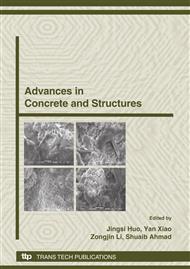[1]
N. Plevris, T.C. Triantafillou and D. Veneziano: Journal of Structural Engineering Vol. 121(7) (1995), pp.1037-1044.
Google Scholar
[2]
A. Okiel, S. El-Tawil and M. Shahawy: Journal of Bridge Engineering Vol. 7(5) (2002), pp.290-299.
Google Scholar
[3]
K. Pilakoutas, K. Neocleous and M. Guadagnini: Journal of Composites for Construction Vol. 6(3) (2002), pp.154-161.
Google Scholar
[4]
D.V. Val: Journal of Structural Engineering Vol. 129(8) (2003), pp.1122-1130.
Google Scholar
[5]
R.A. Atadero, L.S. Lee and V.M. Karbhari: Composite Structures Vol. 70 (2005), pp.430-443.
Google Scholar
[6]
X.Y. Sun, C.K. Huang and B.S. Sun: Journal of Southeast University Vol. 35(3) (2005), pp.427-432.
Google Scholar
[7]
C. Shield, T. Alkhrdaji and A. Okeil: submitted to ACI 440 Subcommittee Task Group on Reliabibity for Shear (2007).
Google Scholar
[8]
Z. He, L.Q. Jiang and Y.C. Huang, in: SAMPE International Symposium, SAMPE, Baltimore, MD (2007).
Google Scholar
[9]
CECS 146: Technical Specification for Strengthening Concrete Structures with Carbon Fiber Reinforced Polymers Laminate (in Chinese). (China Planning Press, China 2003).
Google Scholar
[10]
GB×××××-××××: Technical Code for the Application of Fiber Reinforced Polymers in Civil Engineering (Draft) (in Chinese). (to be published, China 2006 ).
Google Scholar
[11]
GB50010-2002: Code for Design of Concrete Structures (in Chinese) (China Architecture & Building Press, China 2002).
Google Scholar
[12]
GB50009-2001: Load Code for the Design of Building Structures (2 nd edition, in Chinese) (China Architecture & Building Press, China 2001).
Google Scholar
[13]
Z.W. Yin and Y.Q. Qu: Journal of Highway and Transportation Research and Development Vol. 2A(7) (2007), pp.76-81.
Google Scholar
[14]
G. Wu, L. An and Z.T. Lu: Building Structure Vol. 30(7) (2000), pp.16-20.
Google Scholar
[15]
H.D. Ren, C.K. Huang, and J. Yu: Concrete Vol. 163(5) (2003), pp.35-37.
Google Scholar
[16]
A. Khalifa, and A. Nanni: Construction and Building Materials Vol. 16 (2002), pp.135-146.
Google Scholar
[17]
A. Khalifa, and A. Nanni: Cement and Concrete Composites Vol. 22(2) (2000), pp.165-174.
Google Scholar
[18]
A. Khalifa, G. Tumialan, A. Nanni, and A. Belarbi, in: Fibre Reinforced Polymer Reinforcement for Reinforcement Concrete Structures, edited by C.W. Dolan et al, American Concrete Institute, Farmington Hills, MI (1999).
DOI: 10.1142/9789812704863_0117
Google Scholar
[19]
A. Khalifa, L.D. Lorenzis, and A. Nanni, in: Advanced Composite Materials in Bridges and Structures, edited by J.L. Humar, Canadian Society for Civil Engineering, Ottawa, Canada (2000).
Google Scholar
[20]
C. Diagana, A. Li, B. Gedalia, Y. Delmas: Engineering Structures Vol. 25 (2003), pp.507-516.
DOI: 10.1016/s0141-0296(02)00208-0
Google Scholar
[21]
C. Deniaud and J.J.R. Cheng: Journal of Composites for Construction Vol. 7(4) (2003), pp.302-310.
Google Scholar
[22]
C. Deniaud and J.J.R. Cheng: ACI Structural Journal Vol. 98(3) (2001), pp.386-394.
Google Scholar
[23]
B.B. Adhikary, H. Mutsuyoshi and M. Ashraf: ACI Structural Journal Vol. 101(5) (2004), pp.660-668.
Google Scholar
[24]
A. Aprile and A. Benedetti: Composites: Part B Vol. 35 (2004), pp.1-25.
Google Scholar
[25]
J.F. Chen, J.G. Teng: Construction and Building Materials Vol. 17 (2003), pp.27-41.
Google Scholar
[26]
J. F. Chen and J. G. Teng: Journal of Structral Engineering Vol. 129(5) (2003), pp.615-625.
Google Scholar
[27]
Z. Tan and L.P. Ye: China Civil Engineering Journal Vol. 36(11) (2003), pp.12-18.
Google Scholar
[28]
X.S. Feng and Z.F. Chen: Industrial Building (supplement), (2004), pp.89-93.
Google Scholar
[29]
Z.H. Shi, D.X. Hu and J.F. Chen: Building Science Vol. 18(supplement 2) (2002), pp.50-57.
Google Scholar
[30]
D.X. Hu and K.Z. Ma: Journal of Building Structures Vol. 8(3) (1987), pp.18-24.
Google Scholar
[31]
J. P. Jin: Master thesis, Northeastern University, China, (2008).
Google Scholar
[32]
H. Zhu and J.W. Zhang, in: Application of Fiber Reinforced Plastics (FRP) in Civil Engineering, edited by Q.R. Yue, Tsinghua University Press, Kunming, China (2002).
Google Scholar
[33]
R. Rackwitz and B. Fiessler: Computers & Structures Vol. 9 (1978), pp.489-494.
Google Scholar


